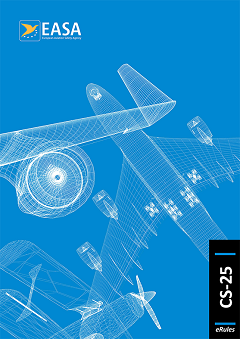ED Decision 2014/026/R
(a) Pressurised cabins and compartments to be occupied must be equipped to provide a cabin pressure altitude of not more than 2438 m (8000 ft) at the maximum operating altitude of the aeroplane under normal operating conditions. If certification for operation over 7620 m (25 000 ft) is requested, the aeroplane must be able to maintain a cabin pressure altitude of not more than 4572 m (15 000 ft) in the event of any reasonably probable failure or malfunction in the pressurisation system.
(b) Pressurised cabins must have at least the following valves, controls, and indicators for controlling cabin pressure:
(1) Two pressure relief valves to automatically limit the positive pressure differential to a predetermined value at the maximum rate of flow delivered by the pressure source. The combined capacity of the relief valves must be large enough so that the failure of any one valve would not cause an appreciable rise in the pressure differential. The pressure differential is positive when the internal pressure is greater than the external.
(2) Two reverse pressure differential relief valves (or their equivalents) to automatically prevent a negative pressure differential that would damage the structure. One valve is enough, however, if it is of a design that reasonably precludes it’s malfunctioning.
(3) A means by which the pressure differential can be rapidly equalised.
(4) An automatic or manual regulator for controlling the intake or exhaust airflow, or both, for maintaining the required internal pressures and airflow rates.
(5) Instruments at the pilot or flight engineer station to show the pressure differential, the cabin pressure altitude, and the rate of change of the cabin pressure altitude.
(6) Warning indication at the pilot or flight engineer station to indicate when the safe or pre-set pressure differential and cabin pressure altitude limits are exceeded. Appropriate warning markings on the cabin pressure differential indicator meet the warning requirement for pressure differential limits and an aural or visual signal (in addition to cabin altitude indicating means) meets the warning requirement for cabin pressure altitude limits if it warns the flight crew when the cabin pressure altitude exceeds 3048 m (10 000 ft).
(7) A warning placard at the pilot or flight engineer station if the structure is not designed for pressure differentials up to the maximum relief valve setting in combination with landing loads.
(8) The pressure sensors necessary to meet the requirements of sub-paragraphs (b)(5) and (b)(6) of this paragraph and CS 25.1447(c), must be located and the sensing system designed so that, in the event of loss of cabin pressure in any passenger or crew compartment (including upper and lower lobe galleys), the warning and automatic presentation devices, required by those provisions, will be actuated without any delay that would significantly increase the hazards resulting from decompression.
[Amdt 25/15]
CS 25.843 Tests for pressurised cabins
ED Decision 2003/2/RM
(a) Strength test. The complete pressurised cabin, including doors, windows, and valves, must be tested as a pressure vessel for the pressure differential specified in CS 25.365(d).
(b) Functional tests. The following functional tests must be performed:
(1) Tests of the functioning and capacity of the positive and negative pressure differential valves, and of the emergency release valve, to simulate the effects of closed regulator valves.
(2) Tests of the pressurisation system to show proper functioning under each possible condition of pressure, temperature, and moisture, up to the maximum altitude for which certification is requested.
(3) Flight tests, to show the performance of the pressure supply, pressure and flow regulators, indicators, and warning signals, in steady and stepped climbs and descents at rates corresponding to the maximum attainable within the operating limitations of the aeroplane, up to the maximum altitude for which certification is requested.
(4) Tests of each door and emergency exit, to show that they operate properly after being subjected to the flight tests prescribed in sub-paragraph (b)(3) of this paragraph.
